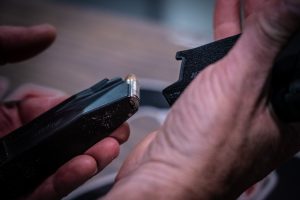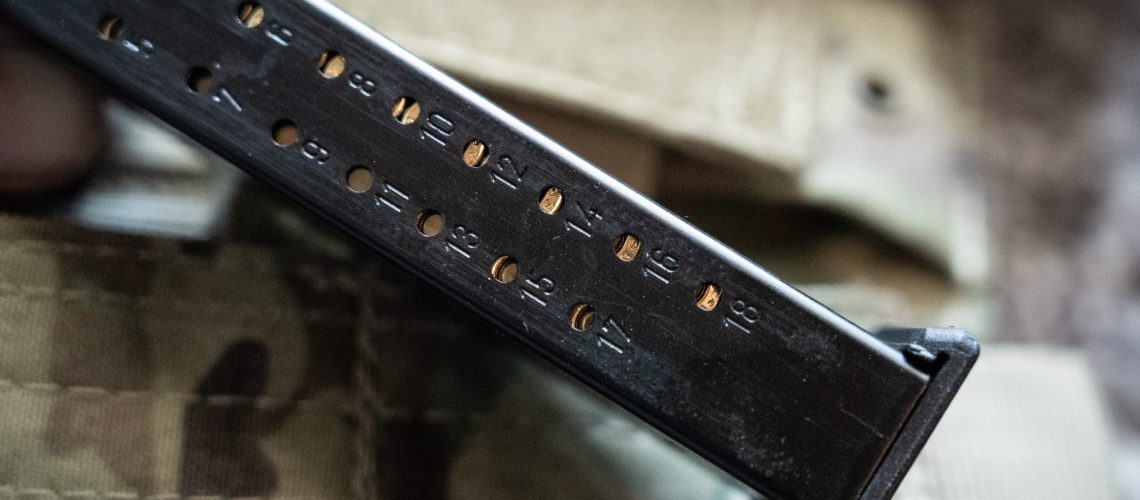Every hobby has its divisive argument. Two-stroke vs four-stroke dirt bikes, console vs PC gaming, paperback vs hardcover books, etc. In the world of handgun shooting, the eternal 9mm vs 45acp debate continues in forums and gun ranges nationwide. Here, we provide the merits of these arguments to help you decide which caliber is right for you.
History: 9mm, also known as 9x19mm Parabellum, is a .355 caliber cartridge created for the German Luger handguns in 1901. It became a ubiquitous submachine gun cartridge with use in the MP40, Sten, Uzi and MP5 to name a few. Starting in the late 70s/early 80s, 9mm grew in popularity with recreational and competition shooters due to the slew of 9mm handguns entering the market like the Beretta 92FS, Glock 17, and Sig Sauer P226. Today, 9mm is the most common pistol and pistol caliber carbine cartridge in use.
45acp (Automatic Colt Pistol) is a .452 caliber cartridge created by John Moses Browning in 1904. It first found popularity in the Colt 1911 and 1911a1 pistols. They became very popular for their power compared to other autoloading handguns at the time. These pistols were standard issue for the US military from 1918-1985. Along with the 1911a1, 45acp was used extensively by the US in WWII with the Thompson submachine gun and M3 Grease Gun. Following the war, 45acp remained a popular civilian handgun cartridge due to the popularity of Colt 1911a1 pistols, especially the later 70 Series.
As 9mm gained popularity, 45acp decreased in popularity among some. To understand why, it is important to consider the characteristics of the two cartridges.

Capacity: 9mm is about 33% smaller in diameter than 45acp. This allows for a higher capacity magazine compared to a 45acp magazine of the same footprint. For example, the 9mm Glock 17 magazine has a 17 round capacity while the 45acp Glock 21 magazine capacity is 13 rounds. The 9mm cartridge is also lighter due to its smaller size compared to 45acp. 9mm has the quantity, but does it have the quality of performance?
Performance: The most common 9mm loading, 115gr FMJ (Full Metal Jacket) Federal, will travel 1,180fps and deliver 355ft/lbs of energy. Other variations can push this up to 1,400fps and 501ft/lbs. Meanwhile, the most common 45acp, 230gr FMJ Winchester, will travel 835fps and deliver 356ft/lbs of energy. The primary argument against 45acp comes from this performance as you are getting roughly the same energy from a round that gives you less magazine capacity. So why was the 45acp seen as more powerful than 9mm when the 1911 was developed?

Ballistics: For much of the 20th century, FMJ bullets were by far the most widely used both for target shooting and self-defense. It was simply the most widely available. The wound channel of a FMJ bullet will only be about as wide as the diameter of the bullet is. Here, 45acp had an advantage because it could create a larger diameter wound channel and potentially be more effective for self-defense. However, in the latter part of the 20th century, hollow point ammunition grew in popularity for self-defense. The “mushrooming” effect of hollow point ammunition on soft targets allows a .355in 9mm bullet to expand to over .500in while a .452in 45acp bullet expands to over 0.600in (both Hornady XTP). These advancements in ballistics give modern 9mm shooters a cartridge with a higher velocity than 45acp, a larger wound channel than FMJ 45acp, and a higher capacity than 45acp. The modern hollow point 45acp wound channel is bigger than FMJ and hollow point 9mm, but it is up to the shooter to decide if this is worth the tradeoff with capacity and velocity. Another consideration is that hollow point bullets do not always expand as they should so this should not be your only consideration when choosing between 9mm and 45acp.
The Niche: There is one area where 45acp has found great popularity, suppressors. Bullets break the sound barrier at around 1,100fps. When this happens, there is a sonic boom that sounds like a loud crack regardless of whether you are using a suppressor. Because standard 230gr FMJ 45acp travels around 835fps, it is naturally subsonic and quieter suppressed than supersonic rounds like 115gr 9mm. The subsonic qualities of 45acp have allowed it to find a niche in the suppressed MAC 10 submachine gun used in Vietnam and the suppressed Heckler and Koch Mark 23 handgun developed for USSOCOM (United States Special Operations Command) in the 1990s. While subsonic variants of 9mm exist in the 147gr bullet weight, the ability to shoot common 230gr 45acp subsonic makes it a popular choice for suppressor users.

So, Which Is Better?: 9mm and 45acp were developed over 120 years ago. Firearms design and ballistics have advanced by leaps and bounds in that time, but these two cartridges have remained a standard offering due to their wide adoption. To say which is better than the other depends on your uses, your preferences in firearms, and what ammo is available for you. If you live in a state with a 10-round magazine capacity limit, the capacity tradeoff between 9mm and 45acp may not be a factor for you. If you don’t plan on using a suppressor, subsonic rounds might not be something you would consider when choosing a caliber. Whichever you choose, the most important thing is to practice as much as possible to become proficient with your firearm. Differences in caliber matter far less than differences in skill.

